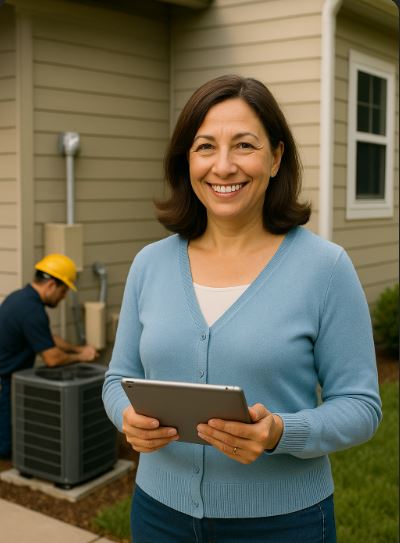Hey friends! 👋
It’s Samantha here—your go-to guide for all things HVAC made simple. You’ve got your sleek new R‑32 AC and air handler system installed (yay!), but now you’re noticing that one bedroom turns into an icebox while the living room still feels stuffy. 😖 Sound familiar?
Let’s talk about air handler balancing, the often-overlooked step that makes a world of difference in your home’s comfort. The good news? It’s easier to understand than you might think—and I’m walking you through every step. 🧡
🎯 What Does “Balancing” Even Mean?
When we talk about balancing your air handler, we’re simply making sure that the right amount of air reaches each room in your home. Every space needs a different amount of airflow based on:
-
Room size 📏
-
Distance from the air handler 📍
-
Ductwork design and bends 🌀
-
How much sunlight or insulation that room gets ☀️🧱
It’s like fine-tuning the volume for each room—just in airflow instead of sound!
For more information on air balancing, This Old House shares that proper air balancing can reduce temperature differences between rooms by up to 5°F, making your home more comfortable and your energy bills lower 💸
🧭 Step-by-Step Airflow Balancing Guide
Let’s jump into the process. Whether you’re doing this with your HVAC pro or tackling it DIY-style, these steps will help you get even airflow across your home:
🛠️ 1. Start with a Clean Slate
Before adjusting anything, make sure:
-
Your air filter is clean
-
All supply vents are fully open
-
No furniture or rugs are blocking airflow
This alone can solve a surprising number of comfort complaints! Energy Star recommends checking your filter monthly and changing it every 1–3 months, depending on usage and dust levels.
🧪 2. Measure Supply Temps and Airspeed
Here’s where things get a little hands-on (but fun!):
-
Use a digital thermometer to measure air coming from each supply vent.
-
Use an anemometer (you can get one online for under $30) to measure the airflow in feet per minute.
This gives you a basic benchmark of what’s happening room by room.
Need a walkthrough? Check out this beginner-friendly guide on measuring airflow and interpreting the results from HVAC School.
🎯 3. Adjust the Dampers
Now the real magic begins:
Look for manual dampers in your ductwork—these are metal levers or valves that control airflow to specific branches of the system. You’ll typically find them near where the ducts branch off from the main trunk.
Here’s how to balance things out:
-
Too much airflow in a room? Slightly close the damper feeding that duct.
-
Too little airflow in another room? Open that damper more, and reduce airflow to others to redistribute pressure.
📏 Rule of thumb: make small adjustments (about 15° at a time), then wait 24 hours to feel the results before tweaking again.
No dampers in your ductwork? No problem! You can also use the louvers on each vent as a mini damper to guide air where you want it.
📲 4. Use Your Thermostat Smarter
If your thermostat only senses temperature in one spot (usually the hallway), you're flying blind when it comes to the rest of your home.
💡 Smart thermostats like the Ecobee Premium include remote room sensors you can place in trouble spots—like upstairs bedrooms or home offices. This helps balance comfort throughout your house without constant manual tweaks.
Pairing smart sensors with your airflow adjustments means total home harmony. ✨
Learn more about how smart thermostats and remote sensors improve comfort at Energy.gov’s Smart Thermostat Guide.
🔄 5. Re-check After a Few Days
After giving the system some time to stabilize:
-
Recheck temperatures in each room
-
Note if hot/cold spots have improved
-
Make small tweaks if needed
Your home might need seasonal tweaks, too. In summer, upstairs rooms usually need more airflow. In winter, it’s the opposite. Adjust accordingly! ❄️🔥
🛑 When to Call a Pro
If you’ve gone through all the balancing steps and still notice significant temperature swings, a deeper inspection may be necessary. A qualified HVAC contractor can perform duct leakage testing and a manual duct analysis to uncover hidden inefficiencies.
For help locating a certified professional, check out this guide from Central Heating & Air Conditioning. It outlines how to find pros who offer proper airflow testing and adjustment—especially useful for homes over 10 years old: Air Balancing: 15 Ways to Avoid Hot and Cold Spots
💡 Final Thought from Samantha
Balancing your air handler may not sound glamorous, but trust me—it’s one of the smartest things you can do for comfort and efficiency. 🧠 A few tweaks today mean no more freezing bedrooms and muggy living rooms tomorrow.
And remember: every home is different, so stay patient, keep notes, and make adjustments gradually. You’ve got this!
Want more tips on getting the most from your HVAC system? Head back to the R‑32 AC + Air Handler Systems collection or check out our full guide on Troubleshooting Mistakes to Avoid next. 🛠️
Until then—breathe easy and stay cool! 💨💚
- Samantha, Home Comfort Advisor







